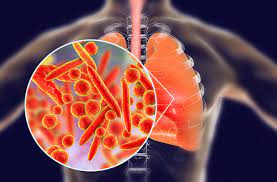Bacterial Pneumonia

A wide variety of bacteria, viruses, and fungi present in the atmosphere can cause pneumonia. Identification of the cause of infection can be an important step in the diagnosis and treatment of pneumonia.
Bacteria
Pneumococcal Pneumonia is the most common type of bacterial Pneumonia. It is caused by Streptococcus pneumonia generally found in the upper respiratory tract. The pathogen infects over 900,000 Americans per year.
Bacterial Pneumonia can develop after a viral cold or flu or it can develop on its own. It is often affecting a single organ or part like one lobe of the lung. This condition is called lobar pneumonia. People who are recovering from surgery, people with weak respiratory systems or people with a viral infection, or people with weakened immune systems.
Some types of bacteria cause Atypical pneumonia. These pneumonia include:
- Mycoplasma pneumonia - A small widely spread bacterium that typically infects people who are younger than 40 years old, particularly those who live or work in crowded places. The infection is often mild enough to not get detected hence sometimes referred to as walking pneumonia as it does not stay in one place and goes undetected.
- Chlamydophila pneumonia commonly infects the upper respiratory organ and can also result in a mild form of pneumonia.
- Legionella pneumophila causes a serious form of pneumonia referred to as Legionnaire's disease. Unlike other bacterial Pneumonia, Legionella is not transmissible from one person to other. An outbreak of the disease has been associated with vulnerability to contaminated water.
These bacterial Pneumonia are known as Atypical because they are caused by organisms that show different Symptoms. These symptoms appear different on chest X-rays or have different reactions to different antibiotics than the normal bacterial Pneumonia. However, the diseases are called Atypical but they are common in occurrence.
Who are in danger of getting pneumonia?

- Pneumonia can occur in any person. However, these groups are most vulnerable to get infected with pneumonia
- Adults above 65 years or more.
- Children below 2 years
- People who are suffering from certain medical problems.
- People who smoke
How is pneumonia diagnosed?
Diagnosis is done based on your recent health histories such as cold, fever, surgery, allergies, or travel history) and the duration of illness. Depending on these factors, your health consultant may diagnose pneumonia simply by a physical exam and thorough brush-up on your medical history. Below mentioned are some tests that may be used to evaluate the diagnosis of diseases.
- Chest X-ray - This test makes images of internal tissues, organs, and bones including lungs.
- Blood test - This test is run on the body to see whether the infection has occurred and if it is present then the spread of infection to the bloodstream is diagnosed through this test.
- Sputum culture - This test is done on the mucus released from coughing from the lungs and into the mouth. It is usually used to identify the presence of infections in the lungs.
- Pulse oximeter- It is a small machine that evaluates the amount of oxygen circulating in the bloodstream. A tiny chip or sensor is installed in the system where you put your finger for scanning. There is a small red light present on the oximeter that glows up when the machine is on. The red light is a sensor for scanning.
- Chest CT scan - This is an imaging medical technique that uses a combination of X-rays and computer technology to produce sharp, horizontal, or ventral images, also called Slices of the body. It is done to visualize any part of the body including bones, muscle, organs, and fat layer. CT scans are more advanced and detailed than regular X-ray screening.
- Bronchoscopy - This is a test for bronchi using a tube called a bronchoscope. This technique helps to measure and diagnose lung problems, detect blockages and collect samples or tissues or fluid for testing.
- Pleural fluid culture - The pleural space is between the chest wall and lungs. A thin, long needle is inserted through the skin lying between the ribs and into the pleural space. Then, the fluid is pulled up into a syringe attached to the needle. Then it is sent to the lab where it is tested to identify which bacteria are using the infection.
How pneumonia can be treated?
The treatment of pneumonia depends on the type of pneumonia. Pneumonia can be treated at home most of the time, but in severe cases, it may be treated in the hospital. Antibiotics are also found to be effective in the treatment of bacterial pneumonia. Antibiotics have also acted as a catalyst in the recovery from mycoplasma pneumonia. We don't have specific treatments for most viral pneumonia. People usually get recover on their own.
Other treatments to recover from Pneumonia may include eating healthy food, proper rest, oxygen therapy, antibiotics, or cough relief medicines if the cough gets severe.
Can pneumonia be prevented?
Get proper immunizations from your health professionals. Pneumonia is caused mainly by the common flu. Due to this, getting a flu shot every year is important s it can prevent both the flu and Pneumonia.
Medical science is advanced in so many ways that now we have a pneumococcal vaccine to prevent pneumonia. The vaccine gives protection against a common form of bacterial pneumonia. Adults over 65 years and children below 5 years should get this shot.
The pneumococcal vaccine is also recommended for all children and adults who have weak immunity due to other health problems.
What are the difficulties that a person faces during pneumonia?
- A majority of people who possess Pneumonia show a positive response to the therapeutics but pneumonia can turn serious and even become lethal.
- Older people or infants are more likely to have complications that may be due to a weakened immune system, or any severe health disease like diabetes or cirrhosis.
These problems may be classified into:
- Acute respiratory distress syndrome (ARDS) - is a severe form of respiratory dysfunctionality.
- Lung abscesses - are lesions of pus that form inside or around the lungs. These pus pockets are required to be drained out by surgery.
- Respiratory failure - this problem requires the application of a ventilator or oxygen mask
- Sepsis - occurs when the infection gets circulated in the bloodstream. It may result in organ failure.
What are the signs of bacterial pneumonia?
At first, people very often with pneumonia have cold or flu symptoms for a few days or weeks that got worse but better
The most common symptoms of pneumonia include:
- Cough - it can be wet producing thick mucus or dry. Cough can stay for 2-3 weeks even after pneumonia got recovers.
- Fever - body temperature of 38°C or higher with shivering and sweating. Although, the temperature can get lower than body temperature in older people.
- Breathing issues - difficulty in breathing especially in young children. Several times rapid or shortness of breathing can also happen in younger children. In children, the skin or ribs can suck in under the skin or the head mat Bob while breathing in babies.
- Fatigue or tiredness
- People usually lose appetite when they're sick
Other symptoms of pneumonia:
- Headache
- Pain in the chest that gets worse with rapid breathing coughing
- Cough up blood
- Pain in the stomach or abdomen area
- Nauseous and may feel vomit
- Ache all over the body
- Confusion or disorientation particularly in older people
- Appear blue pigmentation around the mouth which is called cyanosis, which may happen due to deprived oxygen in more severe cases.
|


 For Videos Join Our Youtube Channel: Join Now
For Videos Join Our Youtube Channel: Join Now










